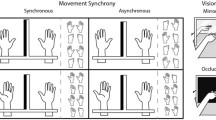Abstract
This study examined the hypothesis that the mirror reflection of one hand’s movement directly influences motor output of the other (hidden) hand, during performance of bimanual drawing. A mirror was placed between the two hands during bimanual circle drawing, with one hand and its reflection visible and the other hand hidden. Bimanual spatial coupling was enhanced by the mirror reflection, as shown by measures of circle size. Effects of the mirror reflection differed significantly from effects of vision to one hand alone, but did not differ from a control task performed in full vision. There was no evidence of a consistent phase lead of the visible hand, which indicates that the observed effects on spatial coupling were immediate and not based on time-consuming feedback processes. We argue that visual mirror symmetry fools the brain into believing it sees both hands moving rather than one. Consequently, the spatial properties of movement of the two hands become more similar through a process that is virtually automatic.


Similar content being viewed by others
References
Carlton LG (1981) Processing visual feedback information for movement control. J Exp Psychol Hum Percept Perform 7:1019–1030
Carson RG, Thomas J, Summers JJ, Walters MR, Semjen A (1997) The dynamics of bimanual circle drawing. Q J Exp Psychol 50A:664–683
Flanagan JR, Wing AM (1993) Modulation of grip force with load force during point-to-point arm movements. Exp Brain Res 95:131–143
Flanagan JR, Wing AM (1995) The stability of precision grip forces during cyclic arm movements with a hand-held load. Exp Brain Res 105:455–464
Flanagan JR, Wing AM (1997) The role of internal models in motion planning and control: evidence from grip force adjustments during movements of hand-held loads. J Neurosci 17:1519–1528
Franz EA (1997) Spatial coupling in the coordination of complex actions. Q J Exp Psychol 50A:684–704
Franz EA (2000a) A double dissociation in the cerebral dominance of bimanual control: callosotomy versus callosal agenesis. International meeting of Attention and Performance XIX, Kloster Irsee, Germany, July 2000
Franz EA (2000b) A double dissociation between callosal agenesis and callosotomy participants on a bimanual task. Forum for European Neurosciences, United Kingdom, July 2000
Franz EA (2003a) Bimanual action representation: a window to human evolution. In: Johnson-Frey SH (ed) Taking action: cognitive neuroscience perspectives on the problem of intentional acts. MIT Press, Cambridge, MA, pp 259–288
Franz EA (2003b) The attentional distribution of task parameters to the two hands during bimanual performance of right handers and left handers. J Motor Behav (in press)
Franz EA, Ramachandran VS (1998) Bimanual coupling in amputees with phantom limbs. Nature Neurosci 1:443–444
Franz EA, Zelaznik HN, McCabe G (1991) Spatial topological constraints in a bimanual task. Acta Psychol 77:137–151
Franz EA, Eliassen J, Ivry R, Gazzaniga MS (1996) Dissociation of spatial and temporal coupling in the bimanual movements of callosotomy patients. Psychol Sci 7:306–310
Franz EA, Waldie KE, Smith MJ (2000) The effect of callosotomy on novel versus familiar bimanual actions: a neural dissociation between controlled and automatic processes? Psychol Sci 11:82–85
Franz EA, Zelaznik HN, Swinnen SP, Walter C (2001) Spatial conceptual influences on the coordination of bimanual actions: when a dual task becomes a single task. J Motor Behav 33:103–112
Franz EA, Rowse A, Ballantine B (2002) Does handedness determine which hand leads in a bimanual task? J Motor Behav 34:402–412
Gallese V, Fadiga L, Fogassi L, Rizzolatti G (1996) Localization of grasp representations in humans by positron emission tomography. 2. Observation compared with imagination. Exp Brain Res 112:103–111
Johansson RS, Westling G (1984) Roles of glabrous skin receptors and sensorimotor memory in automatic control of precision group when lifting rougher or more slippery objects. Exp Brain Res 56:550–564
Keele SW, Posner MI (1968) Processing visual feedback in rapid movement. J Exp Psychol 77:155–158
Oldfield RC (1971) The assessment and analyses of handedness: The Edinburgh Inventory. Neuropsychologia 9:97–113
Peters M (1981) Attentional asymmetries during concurrent bimanual performance. Q J Exp Psychol 33A:171–196
Peters M (1985) Constraints in the performance of bimanual tasks and their expression in unskilled and skilled subjects. Q J Exp Psychol 37A:171–196
Ramachandran VS, Rogers-Ramachandran D (1996) Synaesthesia in phantom limbs induced with mirrors. Proc R Soc Lond B 263:377–386
Ramachandran VS, Hirstein W (1998) The perception of phantom limbs. Brain 121:1603–1630
Ramachandran VS, Levi L, Stone L, Rogers-Ramachandran D, McKinney R, et al. (1996) Illusions of body image: what they reveal about nature. In: Llinas R, Churchland PS (eds) The mind-brain continuum. MIT Press, Cambridge, MA, pp 29–60
Rock I (1966) The nature of perceptual adaptation. Basic, New York
Rosetti Y, Desmurget M, Prablanc C (1995) Vectorial coding of movement: vision, proprioception, or both? J Neurophysiol 74:457–463
Semjen A, Summers JJ, Cattaert D (1995) Hand coordination in bimanual circle drawing. J Exp Psychol Hum Percept Perform 21:1139–1157
Stucchi N, Viviani P (1993) Cerebral dominance and asynchrony between bimanual two-dimensional movements. J Exp Psychol Hum Percept Perform 19:1200–1220
Swinnen SP, Jardin K, Meulenbroek R (1996) Between-limb asynchronies during bimanual coordination: effects of manual dominance and attentional cueing. Neuropsychologia 34:1203–1213
Wuyts IJ, Summers JJ, Carson RG, Byblow WD, Semjen A (1996) Attention as a mediating variable in the dynamics of bimanual coordination. Hum Mov Sci 15:877–897
Acknowledgements
Thanks to Barry Dingwall, Jeremy Anderson, and Michael Bowden for their technical expertise and helpful suggestions. This work was funded in part by Otago Research Grant MFU B26 to Liz Franz
Author information
Authors and Affiliations
Corresponding author
Rights and permissions
About this article
Cite this article
Franz, E.A., Packman, T. Fooling the brain into thinking it sees both hands moving enhances bimanual spatial coupling. Exp Brain Res 157, 174–180 (2004). https://doi.org/10.1007/s00221-004-1831-3
Received:
Accepted:
Published:
Issue Date:
DOI: https://doi.org/10.1007/s00221-004-1831-3




